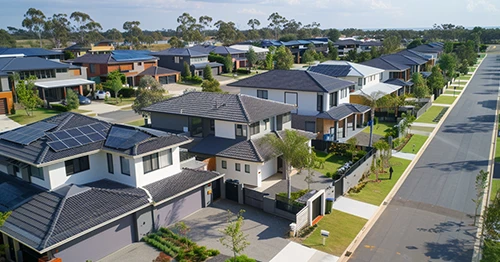Updated: 05 Dec, 2024
Summary
- Australians see a big drop in borrowing capacity, with a 32.58% decrease since 2020 and an 8.17% fall from last year, largely due to a rising RBA Cash Rate.
- Select lenders with low buffer rates (down to 2%) offer a glimmer of hope to boost borrowing capacity.
- A bigger deposit improves LVR and can secure lower interest rates, mitigating borrowing power declines.
- Stage 3 tax cuts and the Help to Buy scheme could soon offer much-needed support for homebuyers.
Have you noticed that dream home you once eyed seems a little further out of reach lately? You’re not alone. With recent interest-rate adjustments, many potential homeowners are wondering how much house they can comfortably afford.
Here at Home Loan Experts, we understand this can be a confusing time. That’s why we want to show you how and why your borrowing power is probably much lower than it was in 2020 – or even in 2023.
The Decline In Borrowing Power – Individuals
| LVR | 2020 Borrowing Capacity (Approx.) | 2024 Borrowing Capacity (Approx.) | % Decrease In Borrowing Power Since 2020 |
|---|---|---|---|
| 80% | $500,000 | $344,050 | 31.19% |
| 90% | $480,000 | $321,600 | 33.00% |
| Above 90% | $460,000 | $314,916 | 31.54% |
Source: Home Loan Experts
Let’s take a look at how borrowing capacity has changed for individuals and couples looking to buy a property. The table above shows the decrease in borrowing capacity for individuals, at different LVRs from 2020 to 2024 (assuming an income of $100,000 a year and a $10,000 credit-card limit).
The Decline In Borrowing Power – Couples
| LVR | 2020 Borrowing Capacity (Approx.) | 2024 Borrowing Capacity (Approx.) | % Decrease In Borrowing Power Since 2020 |
|---|---|---|---|
| 80% | $700,000 | $470,540 | 32.78% |
| 90% | $680,000 | $446,760 | 34.30% |
Source: Home Loan Experts
The picture for couples isn’t much rosier. The table above shows a similar decrease in borrowing capacity for couples looking to invest in property.
Borrowing power has definitely taken a hit in recent years. On average, across all lenders and scenarios, you might have 32.58% less buying power than in 2020 and 8.17% less than just a year ago, in 2023. This decline is primarily driven by rising interest rates. All is not lost, however. We’ll help you understand why these declines have happened, and take a look at what you might be able to do to make up for some lost borrowing power.
How The Cash Rate And Your Deposit Affect Borrowing Power
The amount you can borrow for your dream home goes up or down based on two main factors: the Reserve Bank of Australia’s cash rate and your deposit.
- RBA Cash Rate: This is a big deal because it greatly influences the interest rates lenders offer. A lower Cash Rate means cheaper loans. Back in 2020, the RBA cut rates to record lows, boosting everyone’s borrowing power. But, as rates have climbed since then, borrowing costs have gone up, so naturally, people can’t borrow as much.
- Your Deposit: The size of your deposit and the price of your property determine your Loan-to-Value Ratio (LVR). A bigger deposit means a lower LVR, signalling you’re a safer bet, which can get you better interest rates. Even when the Cash Rate is up and borrowing costs more, having a solid deposit can still help you afford more property, as you may have a lower repayment due to lower interest rates. If you borrow at an LVR of 80% or less, you may also avoid paying Lenders Mortgage Insurance.
Based on these factors, here are a couple of options you can choose to gain back some borrowing power:
- Increase your down payment: Saving a larger deposit can improve your LVR, potentially qualifying you for a lower interest rate.
- Government programs to the rescue: Depending on your situation, you might be eligible for government schemes that support first-time homebuyers, like the upcoming Help to Buy scheme. Also, look into the Stage 3 tax cuts. The cuts start from 1 July and might put more money in your pocket to spend on a home.
The Right Lender Can Help
Here’s the good news: Not all lenders are created equal. Another factor in borrowing power is the buffer rate, which lenders add to your interest rate when determining how much you can borrow – and it can vary among lenders.
We have a non-bank lender in our extensive lending panel that offers some of the most attractive options due to their lower buffer rates (2% in this case, rather than the usual 3%) and lower expense benchmarks. For instance, if your interest rate is 5%, this lender will calculate your borrowing capacity using 7% (5% base rate + 2 percentage points buffer rate), rather than 8%. This is less than many other lenders, which would add a buffer rate of 3 points, cutting deeper into how much you can borrow.
There is currently differentiation among the big four banks, in terms of interest rates across different LVRs. This means you might get better borrowing power by taking care to check all your options. Our Home Loan Experts brokers can help you find the best deals.
We Are Here To Help You!
Our Home Loan Experts brokers are here to answer your questions and help you make informed decisions, because we care. Call us on 1300 889 743 or fill out our free online assessment form.





